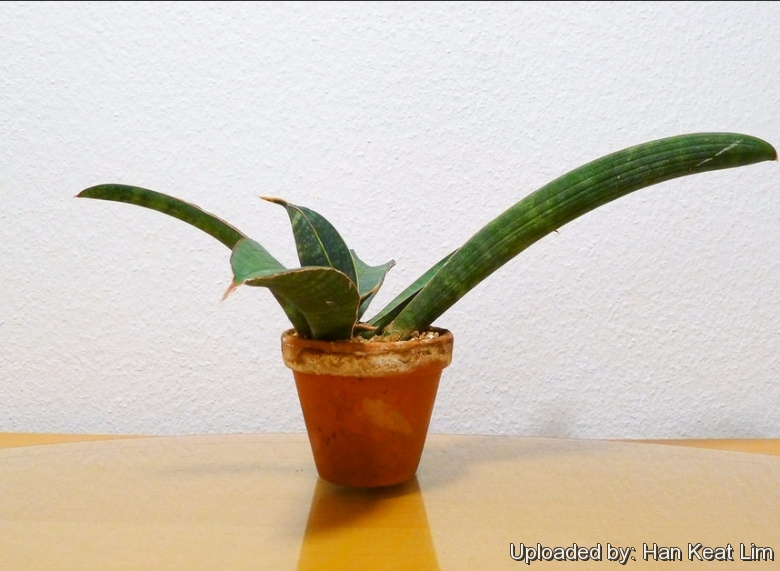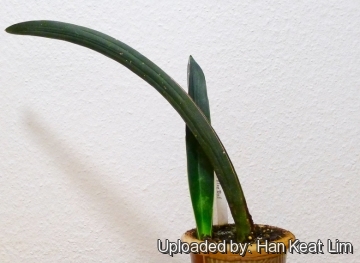




Your support is critical to our success.

Origin and Habitat: Mozambique, Zimbabwe (East Region) and northern Limpopo, South Africa
Altitude range: 175 - 600 metres above sea level.
Habitat and ecology: This species is locally fairly frequent in the shade of shrubs and trees on rocky outcrops.
Synonyms:
- Sansevieria hallii Chahin.
ENGLISH: Baseball Bat
Description: Sansevieria halliiSN|32211]]SN|32212]] is a stemless, perennial succulent growing from a creeping rhizome. This is a very unusual plant with stemless thick leaves and rhizomes. It was described by B. Juan Chahinian in "The Sansevieria Journal" in March 1996. It has been known in cultivation for around ten years as Sansevieria 'Baseball Bat' due to the bat-like appearance of the new leaves. It was collected originally in East Zimbabwe in 1957 at Birchenough Bridge by Harry Hall. Larry Leach also collected a similar plant in 1961 in the same general area. A striated form is in cultivation. There are several other “Bat sanseverias”, and they may all be related.
Derivation of specific name: hallii named after Harry Hall (1906-1986), an English gardener and collector of succulent plants, who worked at Kew Gardens, was Curator of the Manchester Cactus Collection and a horticulturist at Kirstenbosch Botanical Garden.
Rhizome: 1.8-3(-5) cm in diameter, grey-orange.
Leaves: 1-3 per shoot, erect, recurved, 60-90 cm long, 5 cm wide, cylindrical with a deep groove on the upper face (U-shaped in cross-section), dark grey-green with numerous longitudinal lines, and with inconspicuous or no transverse bands, narrowed to a 6 mm obtuse or rounded tip. Margin often reddish-brown with a white membrane. Surface rough
Inflorescences: Flowers are held in a dense capitate inflorescence less than to 18 cm tall and appear almost straight out of the ground, depending on light conditions. The flowering stem is short and the peduncle up to 7 cm, mostly underground. Raceme to 16 cm in diameter, dense. Bra triangular, 18 mm long, 6 mm wide.
Flowers: White tinged purple. Tube 4.5-7.8 (-9.5) cm long, purplish. Perianth lobes cream or white, 2-2.9 cm long, recurved. Style 7-11.4 cm long exserted for about 1.5 cm.
Fruit: The fruit is a globose, wrinkled, berry about 1 cm in diameter green turning orange.
Similar species: Sansevieria halliiSN|32212]]SN|32212]] is similar to Sansevieria fischeri but much smaller. Also similar to Sansevieria humiflora and Sansevieria sinus-simiorumSN|32212]]SN|32211]].
Bibliography: Major references and further lectures
1) Eggli, U. (ed.) “Illustrated Handbook of Succulent Plants: Monocotyledons” 1-354. Springer-Verlag, Berlin, Heidelberg, New York. 2001
2) la Croix, I. “Dracaenaceae Flora Zambesiaca” 13(2) Page 26, 2010.
3) Mapaura, A. & Timberlake, J. (eds) “A checklist of Zimbabwean vascular plants” Southern African Botanical Diversity Network Report No. 33 Sabonet, Pretoria and Harare Page 90. (2004).
4) Hyde, M.A., Wursten, B.T., Ballings, P. & Coates Palgrave, M. (2016). Flora of Zimbabwe: Species information: Sansevieria hallii.
http://www.zimbabweflora.co.zw/speciesdata/species.php?species_id=114670, retrieved 4 January 2016
5) “British Cactus & Succulent Journal” page 99, Cactus & Succulent Society, 1997
6) Germishuizen, G. & Meyer, N.L. (eds.) “Plants of Southern Africa: an annotated checklist”. Strelitzia 14.: i-vi, 1-1231. National Botanical Institute, Pretoria. 2003.
7) Kamundi, D.A. 2006. Sansevieria hallii Chahinian. National Assessment: Red List of South African Plants version 2015.1. Accessed on 2016/01/04
8) African Plants Database (version 3.4.0). Conservatoire et Jardin botaniques de la Ville de Genève and South African National Biodiversity Institute, Pretoria, "Retrieved 03 January 2016 ", from <http://www.ville-ge.ch/musinfo/bd/cjb/africa/>.

Sansevieria hallii Photo by: Han Keat Lim
The gallery now contains thousands of pictures, however it is possible to do even more. We are, of course, seeking photos of species not yet shown in the gallery but not only that, we are also looking for better pictures than those already present. Read More...
Cultivation and Propagation: Sansevieria halliiSN|32207]]SN|32212]] produce offsets from all sides — a useful method for propagation. It is slow growing but tough and not difficult. A great container plant that needs little care.
Soil: Use a soil mix consisting of 3 parts loam to 1 part of pumice. Always underpot sansevierias.
Moisture requirements: The plants are very drought tolerant and are watered about every other week during the growing season. During the winter months they are watered once a month. Water sparingly and not at all as temperatures dip in winter but can tolerate going months between watering.
Fertilization: They are fertilized once during the growing season with a balanced fertilizer.
Light requirements: Will tolerate low light levels but grows best and flowers if given bright light and even tolerates full sun. In the garden In mild to tropical climates it prefers semishade or shade and it is not fussy.
Hardness: Sansevieria pearsoniiSN|32212]]SN|32207]] is theoretically hardy to -2° C, particularly when dry - but it is best to avoid freezing temperatures. If growing outdoors in frost free areas keep in a covered patio or under an area where plants do not receive winter rainfall.
Heat Tolerance: Excellent.
Propagation: Sansevierias are propagated by cuttings or by divisions taken at any time. Cuttings should be at least 10 cm long and inserted in moist sand. A rhizome will emerge at the cut edge of the leaf.
| Your Actions | |
|---|---|
| Back to Sansevieria index | |
| Back to Dracaenaceae index | |
 |
Back to Succulents Encyclopedia index |
Privacy stantement - Terms and conditions - How to cite - About us - Feedback - Donate




